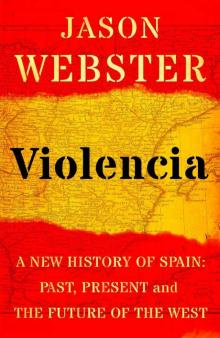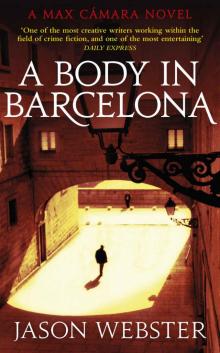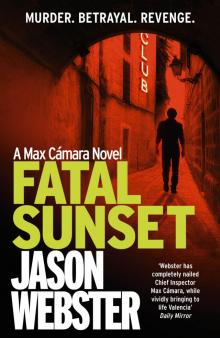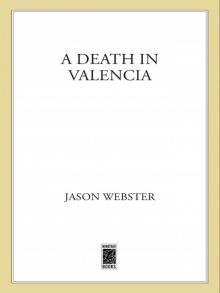- Home
- Jason Webster
Sacred Sierra Page 8
Sacred Sierra Read online
Page 8
El Clossa was a short man with short, grey hair and a protruding nose. Perching himself on a couple of crutches, his weak, semi-useless legs swung from beneath a powerful, compact torso. His eyes, light-blue and glaring, were pointing in the direction of the local postman, still sitting on the sofa from which Salud and I had just got up.
‘Where’s my copy of Walkers Monthly? I haven’t received anything from the stone masons’ guild for weeks. And my local history magazine – the Boletín?’
‘Perhaps you forgot to pay the subscription,’ Jordi said weakly.
‘Like fuck! You just can’t be arsed to pull them out of your pigeonholes and bring them round.’
‘Dinner,’ Pau said with an air of disapproval, ‘is ready. If you’d like to come through to the kitchen.’
The night slowly slipped into a golden haze of excess. Within minutes of finishing the meat stew, and slurping the last drops of wine in his tumbler, El Clossa was slumped half asleep on the table in front of him, while Concha had started singing endless folk songs that all sounded the same.
Pau got up and started to clear away some of the dishes.
‘We should tell them what’s going on here,’ he said, nodding towards Salud and me. ‘Not just pretty songs.’
‘They’ll find out soon enough,’ Concha said, knocking back her drink in one and reaching for the bottle again.
‘What Pau means,’ Marina started gently, ‘is that these mountains, all this beautiful countryside that you’ve started to explore, isn’t going to be around for very much longer. At least not in the way we all know it.’
I’d had too much to drink to think clearly and for a moment felt very confused. What was she talking about?
‘The government,’ Pau started. ‘The government doesn’t care about the things we care about. It doesn’t care about the woods and forests, and the rivers and the wildlife – at least not if it can’t make any money out of them. That’s why they’re slowly destroying this area.’
‘You have to explain properly,’ Concha said, reading the expressions on our faces. ‘Have you heard of Marina d’Or?’ she asked.
For the next hour and a half a picture of The Threat was chaotically and colourfully painted for us. By the time they’d finished it appeared that perhaps there really was something to be concerned about.
The Spanish costas had become a byword the world over for the worst kind of tourist development. Castellón had managed to survive some of the ugliest assaults of the 1960s and 1970s, but speculators, teaming up with local officials, were doing their best to make up for lost time, it seemed. The centrepiece of the new development was a purpose-built resort being constructed along a relatively untouched stretch of coastline: Marina d’Or – the ‘Golden Harbour’. According to Concha, in addition to the already constructed tower blocks providing beach apartments and hotel space for the tourists, they were planning to build ‘Europe’s largest holiday city’ there, with three golf courses, three casinos, a dry-ski run right next to the beach, and a scaled-down version of the Eiffel Tower. The city was going to occupy almost two thousand hectares of what was now mostly orange groves and wetlands, with a resident population of 200,000 people. Offices promoting the resort and offering to sell properties there at ‘once-in-a-lifetime’ prices had been opened in major cities, including London, New York and Beijing.
Unfortunately, the development wasn’t restricted to just one area. A further eleven golf courses were under construction or being planned for the rest of the province – many of them inland, away from the coasts, while clones of Marina d’Or were being pencilled in for the future.
And when it wasn’t tourism, Concha went on, it was heavy industry: the ceramics factory owners made up a powerful lobby – they were the biggest employers in the province – and they wanted more clay. The existing quarries were almost exhausted; there was no choice but to open more. Lorries drove from as far away as Russia to pick up deliveries here – it was a big money earner. The only problem was that it was eating up the very land on which it stood.
What’s more, Pau added, the ceramics factories pumped out arsenic as their furnaces blazed twenty-four hours a day. There were towns nearby with worryingly high levels of child cancer.
And all this industry and tourism needed more roads, and more water. But the rains that had once irrigated these lands could no longer be relied on: reservoirs where once people went boating in summer were now cracked and dry. And it needed more energy to keep it all going, which was why they were building wind farms on every available mountain top. Landscapes that had barely changed for millennia were now hosts to towers of steel whirring and spinning night and day, frightening away the birds and scarring the ancient views. Once you could walk these hills for days with little to remind you of the times you lived in: an antique land and rural culture – perhaps the last of its kind so close to Spain’s Mediterranean coastline – was at your very fingertips here. Now that was endangered, and in some places had gone completely.
The greatest threat, however, was the new airport being built just a few miles away. Every other province on the Mediterranean coast had one – now it was time to fill the gap. Getting here would no longer involve a long drive from Valencia to the south or Tarragona to the north. With the new local airport they’d be able to pour the tourists in from every corner of Europe and beyond. And there was a whole under-developed coastline waiting for them – particularly those jaded by the other stretches of the Spanish coast that had been spoilt by … too many tourists.
The site for the new airport was inland, near the picturesque red-stone hill town of Vilafamés, home of one of the longest established colony of artists and painters in the province. Their peace and tranquillity were about to be destroyed by the landing and taking off of scores of planes every day, spreading their noise and fumes over the mountains.
‘Change’, ‘progress’ – it was all taking place right here in front of us. They all knew what the result would be: we’d all seen it before so often in other parts of the country. Their language was almost hysterical at times, but they were witnessing the beginning of a process that would eventually see fields turned into parking lots, potholed country lanes become smooth tarmac speedways, the farmer with his horse-drawn cart chased off the roads while his newly rich neighbour kicked dirt into his face from the back wheels of his shining SUV. Soon there wouldn’t be a clean, unspoilt vista left in this region, every hillside, every valley marked in some way by the mushrooming spread of holiday homes, flats, villas and hotels. And before long the holiday-makers would be arriving here at the new airport, and many of them would want to stay, meaning more roads, more villas, more golf courses, more concrete obliterating the unspoilt world that still existed – just – in these parts.
Anger and resentment mixed with a fatalistic pessimism seemed to kill the room. This was a cause for them, something to occupy them and bring them together. It was also based on fear – fear of losing the beautiful countryside in which they lived. But there was more than mere cynicism driving them, I felt. More than a desire for it not to happen on their patch. This shouldn’t be happening on any patch – anywhere. How many more Benidorms did the world really need? How many more golf courses and bathroom tiles? When did you say: that’s it, we’ve got enough?
And then there was something else, something unspoken, or less clearly expressed, but there nonetheless: not only dread of what lay in the future, but also a sense that something of worth, of real worth, was in danger of being lost. Something fragile, subtle, that didn’t belong to the brutal, hungry world invading these lands and imposing itself on them. Something to do with the way local workmen still made cloths, cheeses or espadrilles in the same way they had been made for hundreds or thousands of years. Something to do with the way children still played in groups out in the countryside. Something about old widows dressed in black sitting outside their front doors in the evening crocheting tablecloths and napkins. It was about all this and more: you captured
it in moments or visions such as these, but it remained elusive: a timeless, human quality, one that had to be quietly nurtured and protected to survive. None there could give it a name, but I felt sure it lay behind all their talk of ‘witches’ and ‘spirits’ – and it was this that faced the greatest danger.
The Story of Old Mother Misery and the Pear Tree
OLD MOTHER MISERY lived in a mas on the outskirts of the village, where she kept a few chickens running around in a yard, in the middle of which stood a large pear tree. When she wasn’t cooking, or cleaning, she used to go out and about sowing seeds of misery wherever she went, making people’s lives as wretched as she could – making shepherds lose their sheep, farmers lose their crops, children lose their toys and old people lose their wits. So it was no surprise that she didn’t have a single friend in the entire world.
Now Old Mother Misery was getting on in years, and she knew that sooner or later Death was going to appear one day at her door to take her away with him. So one night she sat down to think about what to do and came up with a plan.
The next day she went to Heaven to see God.
‘Oh me,’ said God when he saw her approaching. ‘It’s her again.’
‘God,’ said Old Mother Misery in her high, scratchy voice, ‘I need a favour. Little boys from the village keep coming into my yard, climbing the pear tree and stealing all the fruit! It has to stop!’
‘Well, what do you want me to do about it?’ said God.
‘I want you,’ said Old Mother Misery, ‘to make it so that if ever anyone climbs my pear tree, they won’t be able to get down again unless I go up there myself to fetch them. Just to teach them a lesson.’
Now it did seem to God that this was an odd thing to ask for, but Old Mother Misery had given him enough headaches in the past, and it didn’t seem like too big a task, so he said, ‘If I do this for you, will you promise to go away and leave me in peace?’
‘Certainly,’ said Old Mother Misery.
‘Very well then,’ said God. ‘Consider it done.’
Now about this time the Devil was down in Hell doing his annual inventory check to see how many souls he’d got and who was expected to be joining them in the near future.
‘Death,’ he called out to Death. ‘Isn’t it about time Old Mother Misery was making her way down here? She’s certainly getting on a bit. Why don’t you go and pay her a visit?’
So Death set off to find Old Mother Misery’s mas, where he knew she lived.
When he arrived he found Old Mother Misery tending her chickens in the yard.
‘Oh Death,’ she said when she saw his dark black shadow over her. ‘Is that you? Has my time come already? Surely you can spare me for a bit longer yet.’
But Death was implacable. ‘Come along now,’ he said. ‘You’ve been here far too long already. It’s about time we got going.’
‘Oh but please,’ said Old Mother Misery. ‘It’s going to be a long journey. Couldn’t we take something with us to eat in case we get hungry along the way. I’ve got some lovely ripe pears up in that pear tree if you’d be so good as to climb up and get some.’
‘Good idea,’ said Death. ‘You’re right, it is a long way, and doubtless I’ll be wanting something myself during the journey. I’ll just nip up and get those delicious looking pears up there at the top.’
And so it was that Death climbed the tree to pick some pears. But no sooner did he have the fruit in his hands than he realised he was stuck and couldn’t get down again.
‘Hah!’ cried Old Mother Misery. ‘I’ve got you now. You’re trapped, and you shan’t be taking me anywhere.’
Death cried out and cried out, but all to no avail. It looked like he was going to be there for a long time, perhaps even for ever.
Now with Death stuck up Old Mother Misery’s pear tree, nobody was dying: builders fell from their scaffolding and survived; sailors were shipwrecked at sea but didn’t drown; children went hungry but didn’t starve. After this had been going on for some time, back down in Hell the Devil began to suspect something.
‘Haven’t had any new batches of souls recently,’ he muttered to himself. ‘Come to think of, we haven’t seen Death around for quite some time … not since I packed him off to fetch Old Mother Misery.’
So he decided to set off to find out for himself what was going on.
Now up on Earth everyone was dancing and singing and having fiestas right, left and centre because no one was dying any more, so it took the Devil quite a time to push his way through the crowds before he reached Old Mother Misery’s mas. There, to his surprise, he found Death sitting up in the pear tree.
‘What’s going on? Why aren’t you working?’
‘I’m stuck,’ said Death despondently, for he had been there a long time and was feeling very sore. ‘I can’t get down unless Old Mother Misery comes up to get me.’
Just at that moment, Old Mother Misery appeared. ‘Ah,’ she said when she saw the Devil. ‘I thought we might be getting a visit from you soon.’
‘What have you done to Death? I need him urgently. Release him from there at once or I’ll drag you down to Hell myself!’
‘How dare you talk like that to me!’ she said in a shriek. The Devil was taken aback for a moment: he wasn’t used to being shouted at. ‘This is my house,’ said Old Mother Misery, ‘and no one will tell me what to do.’
‘But I need Death,’ said the Devil, more humbly this time. ‘Everyone’s out having parties all the time, while the fires of Hell need stoking with new souls.’
‘I’ll only get Death down for you if you promise to leave me in peace and never come back.’
The Devil thought it over for a moment. He wasn’t actually sure if he wanted the old witch down in Hell with him anyway, so he agreed. Old Mother Misery climbed up the pear tree and released Death, and within a flash the two of them vanished, and were never seen at Old Mother Misery’s mas ever again.
And that is why Misery still walks the Earth. Although some say that one day, perhaps soon, Old Mother Misery will get tired of being so old and causing so much sadness in the world, and that she will pop off down to Hell of her own accord, for a long rest.
NOVEMBER
The Latin November is called Tishrin el Tsani in Syriac and Azarmah in Persian. It is the last month of autumn and is made up of thirty days. Now is the time for sowing wheat, oats, beans and flax: start sowing from the middle of the month if Allah has made it rain at that time: thirteen days thence around the time of the setting of the Pleiades, what has been sown will already have taken root. November is the month for collecting acorns, chestnuts, myrtle berries and sugar cane. According to the writer Azib, owing to the threat of frosts from this time onwards, the roots of trees and plants should be protected with fertiliser. This is also the time for harvesting saffron.
The cold begins to reach certain areas, and the first snow falls. Starlings, swallows, pelicans and other birds start to migrate south. It is a good month for planting trees. The writer Abu al-Khayr says the sap in trees settles at this time, causing leaves to fall. In Seville I have seen round radishes and the local lettuce – with pointed leaves – planted, for picking in January, and spinach, for harvesting in December.
Ibn al-Awam, Kitab al-Falaha, The Book of Agriculture, 12th century
FOUR AND A half thousand feet up a frozen mountain, I sat shivering in a school hall, waiting for the Third Annual Spanish Truffle Conference to begin. Huddled around an inadequate gas heater were three professors of ‘truffle-ology’, a handful of local farmers and Salud’s nephew and myself. Bizarrely, the tiny village where it was being held – an old Templar territory from the thirteenth century – had its own television channel, and the cameras were there to record this, perhaps the most important event of the year.
‘That’s Santiago Reyna,’ Vicente whispered loudly in my ear as we tried in vain to keep warm: there was no sign of autumn up here, I noticed, late summer having passed directly to midwinter by the feel of
things. ‘He’s the biggest authority on truffles in the whole of Spain!’
I pulled my thin jacket tighter to try and keep in the heat: at that moment the only expert I wanted to see was one on thermodynamics.
I knew next to nothing about truffles, and was not even sure I’d ever tried one. But Vicente, a grinning twenty-year-old with an Afro of bright curly red hair studying forestry science at Valencia University, had assured me in no uncertain terms that this was the future – and an ideal venture for our new farm. Glancing around the hall at the dozen or so other participants, all wrapped up in scarves and hats against the cold, I had my doubts. If he was right, the rest of Spain had yet to catch on.
It appeared as if the organisers of the event were waiting for more people to show up, but after a delay of about an hour, they finally decided to start. Vicente pulled out his exercise book and pen, breathing on his fingers to try and warm them up.
‘I want to study with this guy,’ he said, his eyes glazing over as Santiago, a well-fed, middle-aged man with an air of authority stood up to address the meagre audience. ‘There’s nothing he doesn’t know about truffles.’
Over the course of the next couple of hours, he and his colleagues helped lighten some of the darkness of my truffle ignorance.
The most famous kind of truffle, I learned, was the white variety – tuber magnatum – which was only ever found in northern Italy. This is the one that often makes it into newspaper articles, where x (famous person or restaurant) is reported to have spent y (ridiculous amount of money) for z (tiny morsel of the stuff). It is very rare, being almost impossible to cultivate artificially or farm.
Black truffles – tuber melanosporum – sometimes called black winter truffles, are not quite as expensive but are very much sought after and can command impressive amounts of money. They are most commonly found in southern France and here in north-eastern Spain and are not to be confused with Chinese truffles – tuber sinensis – which look similar but taste of nothing and are often used by unscrupulous suppliers to bulk out their wares by placing a real truffle at the top of the jar for the smell so that no one can tell the difference. The advantage of black truffles is that – unlike their white cousins – they can, to some extent, be cultivated. Through a process called mycorrhisation, spores can be impregnated into the roots of a baby tree. Often this is a variety of oak, but hazelnut and other species can also be used. Several years after planting – anything up to ten years – they start producing their first yield. Specially trained pigs or dogs are needed to find this elusive crop, which grows a foot or so under the ground and is almost invisible to the human eye owing to its soil-like colour.

 Violencia
Violencia Or the Bull Kills You
Or the Bull Kills You The Killing of El Niño Jesús
The Killing of El Niño Jesús The Spy with 29 Names
The Spy with 29 Names Duende
Duende Guerra
Guerra Sacred Sierra
Sacred Sierra A Body in Barcelona: Max Cámara 5
A Body in Barcelona: Max Cámara 5 Fatal Sunset
Fatal Sunset A Death in Valencia
A Death in Valencia Blood Med
Blood Med Andalus
Andalus